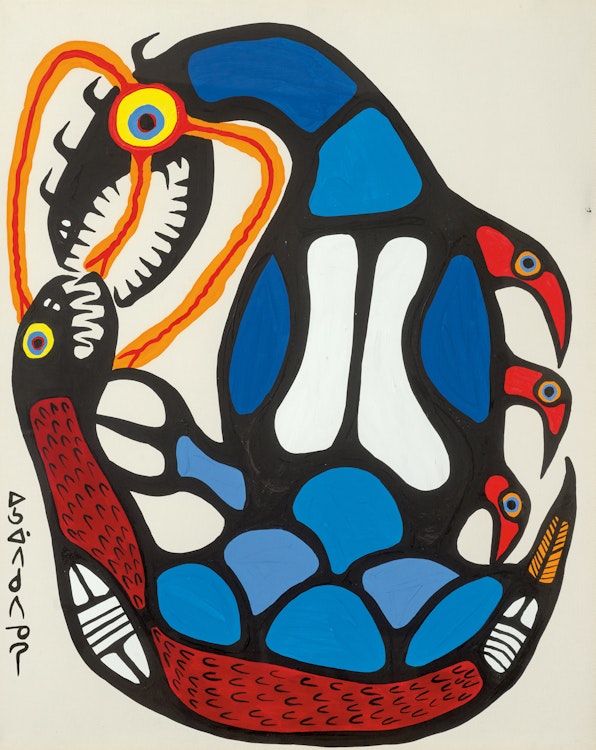Protection of the Young, 1973 by Norval Morrisseau

Norval Morrisseau
Protection of the Young, 1973
acrylic on board
signed in syllabics lower left; titled and dated 1973 on the gallery label on the reverse
39.25 x 31.5 in ( 99.7 x 80 cm ) ( sight )
Auction Estimate: $20,000.00 - $30,000.00
Price Realized $48,000.00
Sale date: May 28th 2025
The Pollock Gallery, Toronto
Private Collection, Toronto
By descent to the present Private Collection, Maine
Lister Sinclair and Jack Pollock, “The Art of Norval Morrisseau”, Toronto, 1979, reproduced page 96
In "Protection of the Young", small, vulnerable birds, filled with a sense of anxiety, cling tightly to the back of the revered Thunderbird. They seek refuge from a menacing serpent that threatens to consume their eggs. With powerful lightning bolts shooting from its mouth and eyes, the Thunderbird stands strong and ready to protect them. From the outset of his artistic journey, Norval Morrisseau incorporated prominent themes from both Anishinaabe culture and Christianity into his work. However, in the mid-1970s, he began to explore a more personal and blended spiritual perspective. During this transformative phase, Morrisseau maintained his collaboration with art dealer Jack Pollock. It was through Pollock's assistant, Eva Quan, that he was introduced to the spiritual movement known as Eckankar. This movement integrates various Eastern spiritual traditions from India and China, and Morrisseau found particular resonance with two key elements: astral travel and the concept of spiritual light.
Share this item with your friends
Norval Morrisseau
(1932 - 2007) RCA, Order of Canada
Norval Morrisseau (also Miskwaabik Animiiki in Anishinaabemowin , meaning "copper thunderbird "), CM, was born in 1932 in northern Ontario. Norval Morrisseau was a self-taught artist of Ojibwe ancestry . He is best known for creating the contemporary Indigenous art movement called the "Woodland School." His deep spirituality and cultural connections guided his career, which spanned five decades. Morrisseau is now considered a pioneer among contemporary Indigenous artists in Canada.
Norval Morrisseau grew up on the Sand Point Reserve (now the Bingwi Neyaashi Anishinaabe First Nation ), on the southeast shore of Lake Nipigon . The first of five children, he was raised by his maternal grandparents. His grandfather, a shaman , taught him Anishinaabe culture and spirituality , while his grandmother taught him the Catholic religion . These two perspectives would greatly influence his future work. At the age of six, Norval Morrisseau was sent to St. Joseph's Indian Residential School in Fort William , Ontario. These schools, which removed Indigenous children from their families, prohibited traditional ceremonies and cultural expression. He later attended a public school near Beardmore, before leaving school for good at the age of 10.
At the age of 19, Norval Morrisseau fell seriously ill. His family held a healing ceremony, during which he was given the name Miskwaabik Animiiki , meaning copper thunderbird . The thunderbird appears in several of his works, such as Untitled (The Transformation of the Thunderbird) , produced around 1958–1960, and Man Transforming into a Thunderbird (1977), composed of six panels.
Norval Morrisseau is the originator of the pictographic style, commonly known as the Woodland School, which revitalized Anishnabe iconography, traditionally incised on rocks and Midewiwin birchbark scrolls. . This style is also sometimes referred to as "X-ray" art because of its emphasis on the outline of people, creatures, and objects. The Woodland School, which fused European and Ojibwe painting styles, relied on the use of bold colors. Although Norval Morrisseau painted primarily on birch bark, many artists after him painted on wood, canvas, and paper, using materials such as acrylic, watercolor, and gouache. Several well-known Indigenous artists employed this style, including Daphne Odjig , Jackson Beardy , and Alex Janvier .
In 1962, Susan Ross, a friend of Norval Morrisseau, approached Jack Pollock of the Pollock Gallery in Toronto to discuss the young artist's work. After meeting him and viewing his work, Pollock agreed to exhibit his work. The artist thus became the first Indigenous person in Canada to have their work presented in a contemporary art gallery. At the time, few Indigenous people were producing works intended to be included and displayed in mainstream society. Most Indigenous creations were analyzed from an anthropological perspective and not as works of modern art.
In 1965, some of his works were displayed at the Glenbow Museum in Calgary , and the following year were exhibited at what is now known as the Musée national des beaux-arts du Québec . It was in the 1960s that the painter succeeded in positioning himself as a significant contemporary Indigenous artist and paving the way for other Indigenous creators.
A self-taught painter, printmaker, and illustrator, Morrisseau created an innovative vocabulary which was initially criticized in the Indigenous community for its disclosure of traditional spiritual knowledge. Morrisseau completed many commissions during his career including the mural for the Indians of Canada Pavilion at Expo 67. He was made a member of the Order of Canada in 1978 and, in 1980, received honourary doctorates from both McGill and McMaster universities. In 1995 Morrisseau was honoured by the Assembly of First Nations. The artist died on December 4th, 2007 in Toronto.

